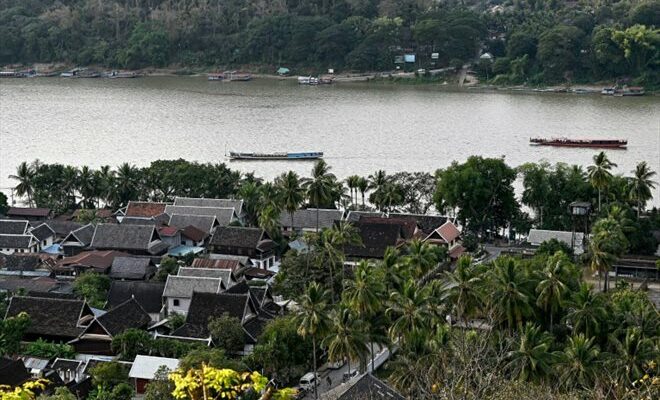The Mekong River in Luang Prabang, January 29, 2024 in Laos (AFP/TANG CHHIN Sothy)
Near Luang Prabang, the construction of a dam on the Mekong River is blocking the future of the tourist capital of Laos, where environmental and heritage defenders are struggling to make themselves heard.
“Today, the landscape is magnificent. You can see the rocks, the river, the gardens on the bank,” describes a tour guide, speaking on condition of anonymity, to protect themselves from the authoritarian government.
“Once they finish the dam, the Mekong will be different,” he concedes.
In Luang Prabang, the cultural jewel of Laos surrounded by mountains and the Mekong, pagodas and old French colonial-style buildings attract hundreds of thousands of visitors per year.

Tourist boats on the Mekong River on January 27, 2024 in Luang Prabang, Laos (AFP/TANG CHHIN Sothy)
But the future of the site, listed as a UNESCO world heritage site, is suspended by the construction of a dam 25 kilometers upstream, which has become the symbol of the growth pushed by the communist regime despite environmental or social concerns.
An estimated cost of 3 billion dollars, 80 meters high, 275 meters wide: the mega-infrastructure must produce 1,460 megawatts of electricity, with commissioning planned for 2030, according to the Laotian press agency.
– Priority to development –
Most of this energy is intended for Thailand and Vietnam, which contribute to construction, said the Mekong River Commission.

Sunset on the Mekong, in Luang Prabang, Laos, January 31, 2024 (AFP/Archives/TANG CHHIN SOTHY, TANG CHHIN SOTHY)
Unesco has expressed “on several occasions its concerns about the preservation of the city of Luang Prabang”, according to an email sent to AFP.
The UN agency calls on the central government to carry out an impact study on the heritage of the former capital of the so-called “million elephant” kingdom.
A drop in the number of visitors would have significant consequences for the city which depends heavily on tourism.
Laos, a poor landlocked country with no industrial base, has relied on hydroelectricity to provide energy to its neighbors, through a series of dams on the Mekong and its tributaries, and to support an economy undermined by inflation and the debts.
Electricity exports brought in $2.3 billion in 2022, according to the Laotian press agency, to the great dismay of environmental organizations which denounce the impact of these infrastructures, some financed by China, on biodiversity or the river level.

Tourist boats on the Mekong River, in Luang Prabang, January 28, 2024 in Laos (AFP/TANG CHHIN Sothy)
“The dams are necessary and they are not in the city,” defends Anda Yangsenexay, deputy head of the municipal service in charge of issues related to heritage, aware of the “disagreements” with Unesco.
“Development must go hand in hand with the preservation of the city, and at the same time, heritage defenders must accept development. The two ideas must go hand in hand,” he insists.
– “A dead river” –
About a hundred kilometers downstream from Luang Prabang, the Xayaburi dam entered service in 2019, despite years of controversy.
Experts remain skeptical of the authorities’ speech.

The Mekong River in Luang Prabang, January 29, 2024 in Laos (AFP/TANG CHHIN Sothy)
“The Mekong has become – and the trend is strengthening – a dead river and essentially a lake, because it is surrounded by dams,” says Brian Eyler, director of the Southeast Asia program at the Stimson Center, a American think tank based in Washington.
The inhabitants of Luang Prabang, particularly those making a living from tourism, are worried about possible repercussions which would scare away visitors.
A 21-year-old young woman, who works on a tourist boat, confides her doubts after finding out about the project on Facebook.
“I’m a little worried because it may affect the number of tourists. If tourists don’t come, we won’t have any income,” she said.
But most residents seem resigned. A 37-year-old man asked about the impact of the dam shrugs his shoulders.
“Senior officials have already signed the contract,” he says. “I don’t dare to speak.”
© 2024 AFP
Did you like this article ? Share it with your friends using the buttons below.




